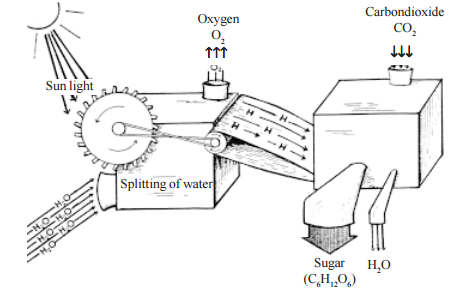Plant physiology – photosynthesis and its significance
Plant physiology – photosynthesis and its significance
Plant physiology is the branch of biological science, which deals with the functioning, and interrelationships of cells, tissues and organs of plants.
Green plants have the capacity of harvesting light energy for life energy, making use of inorganic raw materials.
Most of the living organisms including man depend upon this energy rich compounds of plants.
Plants not only provide food but also supply required oxygen for breathing.
Besides synthesizing organic compounds, plants carry other natural phenomena of living organisms such as respiration, growth and development.
In this chapter, we study these natural phenomena operating in plants.
Though the plants do not have respiratory, circulatory and digestive systems like animals, all these functions are carried out at cellular level.
Photosynthesis
Photosynthesis literally means ‘synthesis with the help of light’.
It is the process that gives life to all living beings.
The plants convert light energy into life energy.
It is the only biological process that makes use of sun’s light energy for driving the life machinery.
Hence, photosynthesis is regarded as ‘leader’ of all processes both biological and abiological.
It is the most fundamental of all biochemical reactions by which plants synthesize organic compounds in the chloroplast from carbondioxide and water with the help of sunlight.
It is an oxidation–reduction reaction between water and carbondioxide.

Significance of photosynthesis
- Photosynthesis is a source of all our food and fuel. It is the only biological process that acts as the driving vital force for the whole animal kingdom and for the non-photosynthetic organism.
- It drives all other processes of biological and abiological world, it is responsible for the growth and sustenance of our biosphere.
- Photosynthesis provides organic substances, which are used in the production of fats, proteins, nucleoproteins, pigments, enzymes, vitamins, cellulose, organic acids, etc. Some of them become structural parts of the organisms.
- It makes use of simple raw materials such as CO2, H2O and inexhaustible light energy for the synthesis of energetic organic compounds.
- It is significant because it provides energy in terms of fossil fuels like coal and petrol obtained from plants, which lived millions and millions of years ago.
- Plants, from great trees to microscopic algae, are engaged in converting light energy into chemical energy, while man with all his knowledge in chemistry and physics cannot imitate them.
History of photosynthesis
- 320 BC Ancient Indians believed that plants fed from their feet ¬ Padapa, refers to a plant which drinks from the feet.
- 1727 Stephen Hales recognised the importance of light and air in the nourishment of plants.
- 1779 Jan Ingen-Housz discovered that the green parts of the plant purify the polluted air in the presence of light.
- 1782 Senebier showed that as the concentration of CO2 increases, the rate of O2 evolution also increases.
- 1845 Von Mayer recognised that green plants convert solar energy into chemical energy of organic matter.
- 1845 Liebig pointed out that the organic matter was derived from CO2 and water.
- 1920 Warburg introduced the unicellular green alga Chlorella as a suitable material to study photosynthesis.
- 1932 Emerson and Arnold showed that the existence of light and dark reactions in photosynthesis.
- 1937 Hill demostrated photolysis of water by isolated chloroplasts in the presence of suitable electron acceptor.
- 1941 Ruben and Kamen used 18O2 to show that O2 comes from water in photosynthesis.
- 1954 Arnon, Allen and Whatley used 14CO2 to show fixation of CO2 by isolated chloroplasts.
- 1954 Calvin traced the path of carbon in photosynthesis and gave
C3 cycle (Calvin cycle) and was awarded Noble prize in 1960. - 1965 Hatch and Slack reported the C4 pathway for CO2 fixation
in certain tropical grasses.
For more information about photosynthesis click here
Other links
Plant tissue culture – origin and techniques
Site of photosynthesis and Mechanism of photosynthesis
Electron transport system and photophosphorylation types
Factors affecting photosynthesis
Test tube and funnel experiment, Ganong’s light screen experiment
Mode of nutrition – Autotrophic, Heterotrophic
Mechanism of Respiration – Glycolysis
Mechanism of Respiration – Oxidative decarboxylation , Krebs cycle
Mechanism of Respiration – Electron Transport Chain, Energy Yield
Ganong’s respiroscope, Pentose phosphate pathway
Plant growth and Measurement of plant growth
Phytohormones Cytokinin, Ethylene, Abscisic Acid, Growth Inhibitors – Physiological Effects
Photoperiodism and vernalization, Phytochromes and flowering
